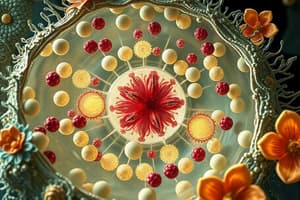Podcast
Questions and Answers
What is the main component of a plant cell wall?
What is the main component of a plant cell wall?
- Chlorophyll
- Cellulose (correct)
- Chitin
- Phospholipids
Which organelle is responsible for photosynthesis in plant cells?
Which organelle is responsible for photosynthesis in plant cells?
- Centrioles
- Mitochondria
- Chloroplasts (correct)
- Vacuoles
What is the primary function of the cell wall in plant cells?
What is the primary function of the cell wall in plant cells?
- To synthesize proteins
- To facilitate transport across the plasma membrane
- To provide support and structure to the cell (correct)
- To store genetic material
Which of the following is not found in plant cells?
Which of the following is not found in plant cells?
What determines the ability of molecules to move across the cell membrane?
What determines the ability of molecules to move across the cell membrane?
Why do lipidsoluble substances cross the plasma membrane without resistance?
Why do lipidsoluble substances cross the plasma membrane without resistance?
What is the purpose of facilitated transport in cells?
What is the purpose of facilitated transport in cells?
What is the significance of a full vacuole in a plant cell?
What is the significance of a full vacuole in a plant cell?
What is the primary function of aquaporins in facilitated transport?
What is the primary function of aquaporins in facilitated transport?
What is the driving force behind diffusion?
What is the driving force behind diffusion?
What type of transport is facilitated diffusion an example of?
What type of transport is facilitated diffusion an example of?
What is the term for the process of water moving from an area of high concentration to an area of low concentration?
What is the term for the process of water moving from an area of high concentration to an area of low concentration?
What is the result of water moving from an area of low solute concentration to an area of high solute concentration?
What is the result of water moving from an area of low solute concentration to an area of high solute concentration?
What is the term for a liquid solvent that dissolves solute particles?
What is the term for a liquid solvent that dissolves solute particles?
Why do molecules move down their concentration gradient?
Why do molecules move down their concentration gradient?
What is the characteristic of a substance that allows it to move by diffusion?
What is the characteristic of a substance that allows it to move by diffusion?
Flashcards are hidden until you start studying
Study Notes
Plant Cells vs Animal Cells
- Plant cells have a protective outer covering called the cell wall, made of cellulose, which provides support for the cell.
- Cell walls are also found in protists, fungi, and bacteria, but in fungi, it is usually made of chitin, a modified polysaccharide.
- Plant cells have chloroplasts, organelles involved in photosynthesis, which contain chlorophyll, giving plants their characteristic green color.
- Most of the cytoplasm in a plant cell is taken up by a large vacuole that crowds the other organelles, which contains cell sap and is a sign of a non-dehydrated plant.
- Plant cells do not have centrioles.
Transport Across Membrane
- The ability of molecules to move across the cell membrane depends on the semipermeability of the plasma membrane and the size and charge of particles.
- Lipid-soluble substances cross the membrane without resistance because "like dissolves like".
- Hydrophilic substances require facilitated transport, which depends on proteins that act as tunnels through the membrane.
- Channels are specialized proteins that only let certain substances through, such as aquaporins, which are water-specific channels.
Passive Transport
- Passive transport occurs when substances move down a concentration gradient to spread out and diffuse into an area with a lower concentration.
- Diffusion is the movement of a substance from an area of high concentration to an area of low concentration.
- Simple diffusion occurs when a hydrophobic molecule diffuses without the help of a channel-type protein.
- Facilitated diffusion occurs when a molecule diffuses with the help of a channel-type protein.
Osmosis
- Osmosis is the diffusion of water from an area of high concentration to an area of low concentration.
- Water moves to dilute concentrated solute particles in a solution.
- Osmosis occurs when water moves down its concentration gradient, from an area with less solute to an area with more solute.
Studying That Suits You
Use AI to generate personalized quizzes and flashcards to suit your learning preferences.



